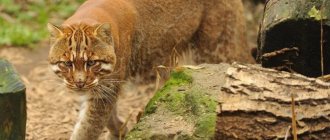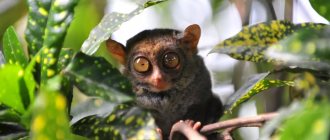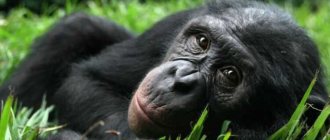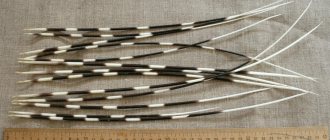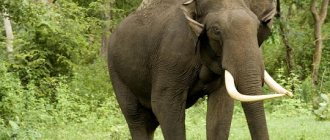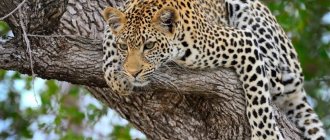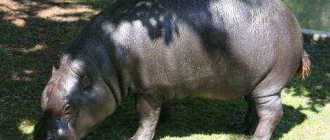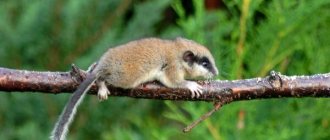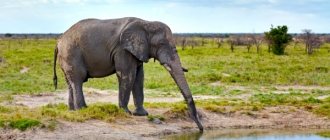- Wild animals
- >>
- Mammals
Hamadryas are a species of the baboon family. It is the northernmost of all existing baboons, native to the Horn of Africa and the southwestern tip of the Arabian Peninsula. It provides a convenient habitat for this species with fewer predators than in central or southern Africa, where other types of baboons live. The Hamadryas baboon was sacred to the ancient Egyptians and appeared in various guises in ancient Egyptian religion, hence its alternative name "sacred baboon".
Description of Hamadryas
The hamadryas is a fairly large monkey, old males reach a body length of up to 1 m, while the tail length ranges from 20 to 55 cm. The body of young males is from 75 to 80 cm in length, for females this figure is 50-60 cm. The weight of adults is from 20 to 30 kg for males, and from 10 to 15 kg for females. The average size of females is usually half that of males. The hair that covers the body of hamadryas is colored gray, reminiscent of dry grass. Males are distinguished by the originality of the arrangement of hair in the area of the head, shoulder body and chest, which together form some semblance of a mane or mantle, due to which the animal received the specific epithet - frilled baboons. The ischial calluses are colored red, the hairless parts of the face are dirty-flesh. The color of females is more rich and dark, their mane is much less pronounced than that of males. The appearance of young hamadryas is more reminiscent of females.
Japanese red-butted macaques
Among monkeys with a provocative coloration of the seat, Macaca fuscata stands a little apart. This is a species of primate that originally lived in a very limited area - in the north of the island of Honshu. Among their relatives, these red-butted macaques stand out because they live in climatic conditions that are unsuitable for monkeys.
Japanese macaques are of medium size: males are no higher than 95 centimeters, no heavier than 14 kilograms. Females are even lower, and in weight they lag behind males by almost one and a half times. These monkeys have very thick and long dark gray fur with a brownish tint. The “face” and buttocks of Japanese primates are bald and scarlet. The tail is short, maximum 10 cm.
Japanese macaques (with red butts) stay in a group, a flock can number up to hundreds of individuals, and a strict hierarchy is observed in it. In its natural habitat, snow can lie for up to four months, and the temperature does not rise above -4 Celsius. Thermal springs help macaques survive the cold, in which they warm themselves. And in order not to freeze when setting out with wet fur for food, Japanese monkeys set up watches. Individuals with dry skin carry food to basking relatives; After a strictly defined period of time, the bearer climbs into the water, and the already warmed one takes up the post.
Japanese primates are very smart animals. To communicate within the community, they use a complex set of gestures and sounds, they tend to wash the collected fruits, and adapt their diet to specific living conditions.
At the end of the 20th century, several individuals of Japanese macaques were brought to Texas and perfectly settled into their new homeland. So now you can watch monkeys not only on the island of Honshu.
Nutritional features of hamadryas
— Advertising —
Hamadryas feed mainly on the roots and fruits of plants, succulent leaves, as well as snails, worms and a variety of insects. On occasion, they willingly feast on bird eggs left unattended. In search of food, they easily turn over stones.
As agriculture developed near the natural habitats of these monkeys, groups of them began to attack plantations, which could cause significant harm to human activities.
Distribution of hamadryas
Hamadryas are common on the African continent in Ethiopia, Sudan, Somalia, Southern Nubia, and they are also found in regions of Asia such as the Arabian Peninsula and Yemen. Everywhere they prefer to live in open areas; in the mountains they are able to rise to considerable heights. But the most important condition for their life in nature is the presence of a nearby source of drinking water.
Hamadryas behavior
Hamadryas form large herds, in which from 100 to 150, and sometimes up to 200 monkeys live together.
This group is often called a family, as it lives very friendly. Old individuals bravely protect and protect young ones from dangers. Such a family is headed by a male of the largest size, who ensures that a clear hierarchy is observed. In addition to him, 10 to 15 old males live in the group. The main male maintains discipline in the family and prevents its dispersal. Usually it is he who notices the approach of predators, and makes special calls to warn everyone else. When people, dogs or predators appear, the entire herd begins to scream and howl deafeningly. Monkeys climb cliffs and push rocks down to protect themselves. The leader's harem consists of several adult females. In general, it is the newborn babies and the female mother who occupy the most important position in the family. Old females and juveniles are at the bottom of the hierarchy.
The hamadryas family leads a nomadic lifestyle over an area of 3-15 km2. When spending the night in shelters (overhangs and rock crevices), the monkeys press tightly against each other. Animal activity begins at dawn, when they begin searching for food and entertainment.
Hamadryas spend most of their time on the surface of the ground rather than in trees. But they are capable of climbing high branches very deftly and skillfully. Also in the mountains and on the slopes of steep rocks, they move no less confidently than on the ground.
To communicate with each other, hamadryas use gestures, facial expressions, glances, and about two dozen different vocal signals (danger, calling on the road, attracting attention to food).
Chakma
The bear baboon is the largest representative of its species in South Africa. Like hamadryas, they live mainly in rocks and feed on everything they can find: roots, lizards, scorpions. Local residents claim that before eating the latter, the chacma carefully removes the poisonous sting.
Bear baboons are very dangerous creatures. They easily deal with dogs and can launch an organized attack.
The chacma's coat is greenish-black, with black withers running along the back and limbs. Babies are born very dark and lighten as they grow older.
Why do some species of baboons (such as baboons and hamadryas) have red butts? These are not the butt itself, these are the ischial calluses, equipped with a large number of blood vessels located close to the surface of the skin. Therefore, the butt appears red and enlarged.
Great apes use many different signals to convey information. Including poses where they expose their butts. The red butt does not provide a functional advantage, but with its help the baboons attract a female for mating and show other males, they say, look what I am, and wow, and what a big red butt, it’s better to avoid me and my females.
Female baboons also use their butts to send a sexual signal to the male. In this case, she openly shows him her butt. The spectacle is truly amazing, since the females of many species of baboons, as ovulation approaches, take on the color of hot red pepper and swell greatly. Copulation is possible only at the moment of maximum enlargement of this organ, so male baboons and chimpanzees have to run all their lives from one red bottom to another. In addition, red color is bright and visible at the greatest distance.
Hamadryas breeding
The male hamadryas, collecting his own harem, often “steals” females from neighboring families.
For this reason, females from different groups, once in the same harem, are often not friends with each other, and the male has to strictly monitor order and discipline, and if they are violated, he inflicts painful bites on the neck. Reproduction in hamadryas is not associated with any specific time of year. In a litter, a female usually has one cub, to which she is very attached. Young hamadryas reach sexual maturity at 4-5 years of age.
The lifespan of hamadryas in nature ranges from 12 to 15 years. In captivity, it becomes significantly longer; individuals with an age of about 30 years have been recorded.
Real red faces or why this monkey's face is scalded
Walking through the forests in the northwestern Amazon, you can encounter amazing creatures.
From behind is an ordinary long-haired primate, but as soon as he turns to face you, genuine horror sets in and the question arises: “Where did the poor fellow manage to scald his face so badly?” The name, to put it mildly, is not the most pleasant. And the appearance leaves much to be desired. The primate's body length is only 45 cm, there is no subcutaneous fat, so all the muscles are simply covered with skin, on which long hair does not grow too thickly.
But on the head it’s not there at all. Moreover, the animal’s muzzle is covered with dense red skin. Moreover, the richer the shade, the healthier the individual.
Skin color influences the choice of partner during the mating period - pale-faced ladies and gentlemen do not arouse interest in the opposite sex.
The monkey's tail is short, growing to a maximum of 15 cm. But the color can vary from white to red and even brown.
Cacajas live in groups, sometimes the number of individuals can reach 100. They are active during the day and rest peacefully in the trees at night. To search for food, red-faced animals are divided into small subgroups in order to find as many tasty treats as possible in different areas.
Animals feed mainly on plant foods - fruits, nuts and sprouts. They move on four legs and can sometimes jump if the situation requires it. Moreover, they spend most of the time on the lower branches, and during motherhood, especially during feeding, they rise quite high.
The mating season is quite peaceful, except for the number of sounds the animals make. After copulation, one baby is born, rarely there are more.
Until 4 months, a caring mother will carry him around and feed him milk. Then the baby will become quite independent, but he will reach sexual maturity only by 3 years, not earlier.
There are not so many monkeys of this genus in nature; they carefully hide from curious bipeds, so it has not yet been possible to thoroughly study their life from the inside. In artificial conditions under human protection, monkeys can live up to 35 years.
These are such strange primates with an eccentric appearance and an equally eccentric name.
Source
Natural enemies of the hamadryas
The main natural enemy of hamadryas is the leopard, but adult males always very actively protect and protect their family from attacks by a predator, and the latter rarely manages to take them by surprise.
People also hunt hamadryas, but old males are very strong and dangerous, they have strong teeth and pose quite a serious danger to an unarmed person.
In recent years, there has been a decline in the natural population of hamadryas. This is most likely due to the reduction of natural areas suitable for animal habitation. For this reason, the species was listed in the Red Book as one that requires protection.
Population and species status
Despite the fact that these primates are not included in the International Red Book, their numbers are constantly decreasing, which causes unfounded fears among specialists in many countries around the world. In China, it is prohibited to trade these animals, so it is not possible to legally obtain such a pet. Despite this, illegal trade continues. The cost of one such pet reaches about 3 and a half thousand dollars.
The cost is quite high, since some jewelry is sold at this price, although the attitude towards animals is not so reverent and attentive. At first, such pets are surrounded with care, but after some time they are simply forgotten about, or even thrown away altogether. Not everyone understands that you should treat a little marmoset the way a person would treat a small child. Therefore, you should not think that a marmoset will have a sufficiently spacious cage, enough treats and a sufficient mass of all kinds of toys. Since these primates live in friendly families, attention and communication are very important for them, the absence of which is extremely difficult for them to tolerate.
Source
Interesting facts about the hamadryas
- For the ancient Egyptians, the hamadryas was the incarnation of the god Babi, and the animal was therefore revered as sacred. In addition, another god - Hapi (son of Horus) - was depicted with the head of a hamadryas. But today, hamadryas are not found in the wild in Egypt.
- In captivity, a young hamadryas quickly becomes tame and shows high intelligence. But as they age, the males become very wild, aggressive and angry.
